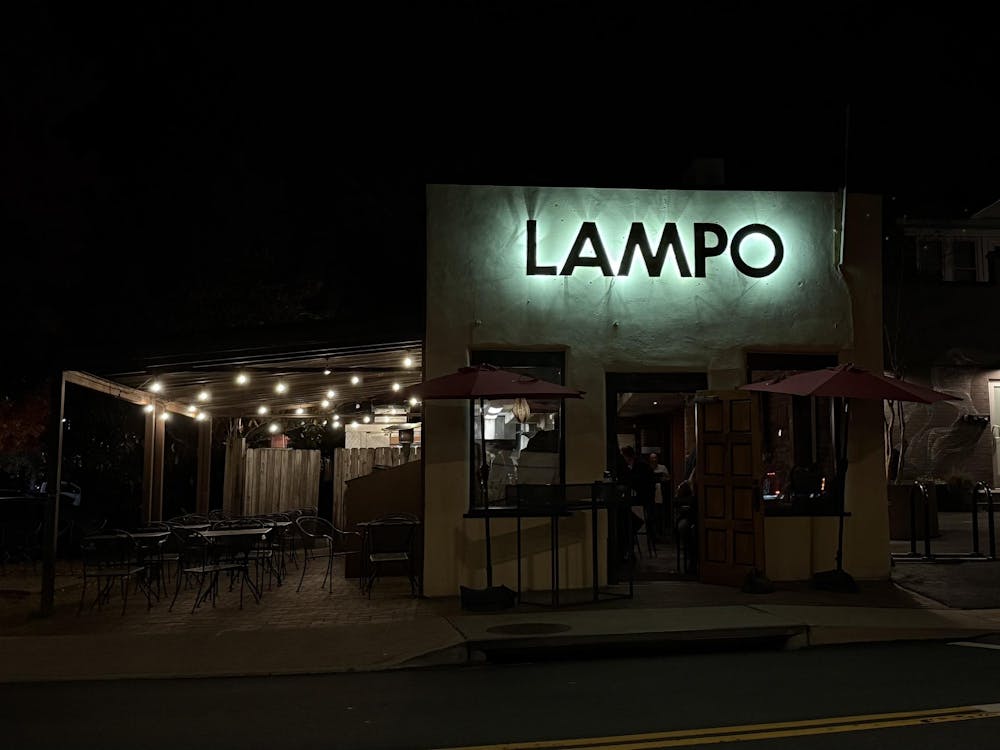Stepping over the blue rope, a couple takes a blanket onto one of the restricted areas of the Lawn. Seconds after they settle themselves into study, the sprinkler nearest their spot comes to life, forcing them to move.
This is no coincidence. Richard Hopkins, assistant landscape superintendent, just punched the coordinates for that particular sprinkler into his controller.
"The blue ropes are to discourage mass usage of the Lawn," explained Scott Burns, Grounds supervisor at Central Grounds, one of Hopkins' colleagues.
These two, together with their boss, Jeff Ertel, landscape superintendent, take the appearance of the Lawn very seriously.
"We don't mind somebody pulling up under a tree and studying," Hopkins said. "But the ropes discourage Frisbee games and mountain bikes. This is the mountain bike era."
Usually, the Lawn is available for use by students. But for two months of the year it remains roped off.
The Lawn is reseeded a month before both convocation, which falls on Oct. 26 this year, and graduation in May. The blue ropes protect the new grass until each event.
"We try to minimize the amount of foot traffic we get while the grass is at its most vulnerable," Hopkins said.
"We would certainly enjoy a little more cooperation from those students who feel it necessary to drag down 50 or a 100 stakes just for the heck of it," Burns added.
The three have no problem, however, with putting the ropes back up after someone has streaked the Lawn.
"When people streak, they only undo the middle two ropes all the way down," Burns said. "At least if you streak you have a reason to take the rope down. Streaking is fine. We don't care about that."
But the southern end of the Lawn where Homer sits is left accessible to the public year round.
"We've always kept Homer less restricted," Burns said.
The three laughed together from their position in the shade on the southern end of the Lawn as Hopkins sets off another sprinkler.
Burns explained that the occasionally sparse appearance of the Lawn is because of the volume of foot traffic it must endure.
"The Lawn's never closed," Burns said.
"Part of the reason the Lawn's a little faded right now is that we had a fungus go through last year," Hopkins said. "We don't treat the Lawn for fungus because in order to do that you have to close it."
Ertel added that few chemicals are used in the maintenance of the Lawn.
"The Lawn is pretty much treated organically," Ertel said.
"Just to give you an example," Burns chimed in, "if you played golf, you'd wear golf shoes, so if the grass has been treated you can still walk on it. Here people lay on the grass and play in bare feet. That's why we don't treat it."
But while students lying on the Lawn are protected from chemicals, they are liable to be attacked by the sprinklers, especially right after reseeding.
"Students have to understand that they could get wet at any time," Ertel said. "Those blue ropes right now are also to keep people from getting wet."
Burns added that it is even easier to target Lawn trespassers thanks to a new sprinkler system that was installed only last year.
"If we can control the amount of water that the turf gets, then we can go a long way towards keeping it a lot healthier throughout the year," Burns explained.
"What used to take about eight man-hours now takes none," Ertel added.
The new sprinkler system also can be used as a means of protecting new grass, as Hopkins had shown earlier with the blanket couple.
Hopkins uses the RotundaCam on the University's Web site to look for people trespassing on the Lawn. Sometimes he turns the sprinklers on them as well.
"It's not close enough to get them wet," Hopkins said.
"We spend an average of $30,000 each year on the Lawn," Ertel said. "Reseeding costs $10,000 each time."
This high cost helps to explain the landscapers' protectiveness of the new grass.
Several different types of grass are planted to suit all of the different microclimates on the Lawn, Hopkins explained.
Caring for the Lawn is such an intensive job that the three can't even stand for 15 minutes without being interrupted by their walkie-talkies.
"Here we go," Burns exclaimed as Hopkins stepped back to answer his beeping walkie-talkie.
Someone was having trouble erecting a tent at Alumni Hall because of the strings of lights in the magnolias.
Burns explained that such incidents are just part of the territory. Hopkins pulled out a cell phone to find someone who could resolve the problem.
Another facet of Lawn care is tree removal. Six trees were removed from the Lawn last year, either because they were diseased or because they had reached their life span, according to Hopkins.
Unfortunately, Burns added, new construction also sometimes calls for tree removal.
"Anywhere that a tree has been removed, we replace it with a new one," Hopkins said. "We make up for it somewhere else."
The Arboretum Landscape Committee must approve all tree removals.
"We have two in-house arborists who evaluate the trees and present a report to the committee," Hopkins said.
The supervisors do much more than seed and water the Lawn, however. They are responsible for the outdoor work for the bulk of Central Grounds.
"Central Grounds is everything this side of Beta Bridge, down the Lawn to JPA out the back of Old Cabell, in the east all the way down to the 14th Street bridge, and to Emmet Street," Burns explained.
Hopkins added that this area covers around 60 acres, but only eight employees maintain it.
The Pavilion Gardens, however, have their own four-man staff, each trained to do more intensive gardening.
In addition to mowing grass and raking leaves, the Central Grounds team also is responsible for clearing traffic areas when it snows.
"Our first responsibility is the streets," Hopkins said. "We're responsible for the emergency access."
In spite of their wish that students would be more respectful of Lawn restrictions during reseeding, all three men hold great affection for University students.
"University students are our lifeblood," Burns said.
"That's why we're here," Ertel agreed.
"Personally speaking, I enjoy it when students use the landscape. A lot of times you'll have leaves piled up and next thing you know three or four people are diving into them. The landscape is here to be used," Burns said.
Spending so much time on the Lawn also encourages interactions with the Lawn residents.
"I always kid them and say 'We're working on your front yard,'" Burns said. "I know the Lawn residents really appreciate this work. They put in three years to be able to have the privilege of living here and we want to make it nice for them."
But Lawn residents are not the only people who appreciate the beauty of the Lawn.
The Lawn was honored last year on tractor engine manufacturer Briggs and Stratton's list of Top Ten Public Lawns.
Other honorees included Gateway Park, the Naval Academy and the Alamo.
"I bet we're the only one maintained organically," Ertel said.






